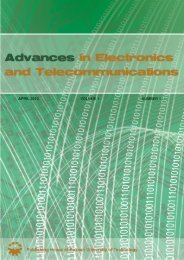november 2010 volume 1 number 2 - Advances in Electronics and ...
november 2010 volume 1 number 2 - Advances in Electronics and ...
november 2010 volume 1 number 2 - Advances in Electronics and ...
Create successful ePaper yourself
Turn your PDF publications into a flip-book with our unique Google optimized e-Paper software.
64 ADVANCES IN ELECTRONICS AND TELECOMMUNICATIONS, VOL. 1, NO. 2, NOVEMBER <strong>2010</strong><br />
B. QW laser model<strong>in</strong>g<br />
In the QW lasers the carrier concentrations <strong>in</strong> SCH <strong>and</strong><br />
QW regions should be dist<strong>in</strong>guished, <strong>and</strong> thus two separate<br />
rate equations for the carriers are <strong>in</strong>troduced:<br />
dNw<br />
dt<br />
dNb<br />
dt<br />
I<br />
= −<br />
eVw<br />
Nb<br />
−<br />
τcap<br />
Nb<br />
+<br />
τe<br />
Nw<br />
τesc<br />
Nb<br />
= −<br />
τcap<br />
Nw<br />
−<br />
τesc<br />
Nw<br />
τe<br />
(7)<br />
− g0(Nw − NT )<br />
S (8)<br />
1 + εgS<br />
where Nw is the carrier concentration <strong>in</strong> the quantum wells,<br />
Nb is some equivalent concentrationrelated with the real SCH<br />
carrier concentration Ns by the relation: Nb = NsVs/Vw,<br />
<strong>in</strong> which Vs <strong>and</strong> Vw are the <strong>volume</strong>s of SCH <strong>and</strong> QW,<br />
respectively. The captur<strong>in</strong>g of the carriers from SCH to QW is<br />
characterized by capture time τcap, <strong>and</strong> (much less efficient)<br />
escap<strong>in</strong>g <strong>in</strong> the opposite direction by τesc. The photon density<br />
depends only on the Nw concentration, thus:<br />
dS<br />
dt = Γg0(Nw − NT )<br />
S −<br />
1 + εgS<br />
S<br />
τP<br />
+ ΓβNw<br />
τe<br />
The frequency chirp depends on both QW <strong>and</strong> SCH carrier<br />
densities, because the optical field lies <strong>in</strong> both regions undergo<strong>in</strong>g<br />
carrier concentration variations. Thus, the chirp may be<br />
expressed as follows [1]:<br />
∆ν = α<br />
4π Γg0(Nw − NwT H) + (1 − Γ)gb(Nb − NbT H) (10)<br />
where NwT H <strong>and</strong> NbT H arethresholdcarrierconcentrations<strong>in</strong><br />
QW <strong>and</strong> SCH, respectively, gb is the coefficient characteriz<strong>in</strong>g<br />
the efficiency of <strong>in</strong>fluence of Nb on the laser frequency.<br />
Unfortunately, this time the chirp cannot be easily related<br />
to the <strong>in</strong>tensity modulation, as it was made <strong>in</strong> (5) <strong>and</strong> (6)<br />
for the bulk lasers. Large signal relation, analogous to (5), is<br />
quite complicated, <strong>and</strong> even after many simplifications needs<br />
at least four parameter values to be determ<strong>in</strong>ed <strong>in</strong> some way.<br />
Similarly, the small signal relation analogous to (6) is also<br />
troublesome <strong>and</strong> needs a large set of parameters [1].<br />
Thus, the question of practical importance arises whether<br />
a relatively simple model of the laser IM <strong>and</strong> FM properties,<br />
based on the bulk laser rate equations, may be adopted for behavioral<br />
(i.e. not strictly connected with physical phenomena)<br />
model<strong>in</strong>g of the QW lasers.<br />
In case of IM characteristics, is was shown <strong>in</strong> [7] that the<br />
effects aris<strong>in</strong>g from the carrier accumulation <strong>in</strong> the SCH may<br />
be simply modeled by a first order low-pass filter with time<br />
constant equal to τcap, preced<strong>in</strong>g the bulk model of the <strong>in</strong>ner<br />
QW structure. It may be also shown that for QW lasers with<br />
any low capture time the difference <strong>in</strong> the IM properties of<br />
models described by Eqs. (1), (2) <strong>and</strong> (7) ... (9) practically<br />
vanishes.<br />
III. SMALL-SIGNAL CONSIDERATIONS<br />
First, the small-signal chirp characteristics aris<strong>in</strong>g from the<br />
QW laser model based on the rate equations (7) ... (10)<br />
will be analyzed. Us<strong>in</strong>g this model <strong>and</strong> start<strong>in</strong>g from two<br />
experimentally verified sets of its parameters, taken from [9],<br />
the laser FM efficiency versus modulation frequency was<br />
obta<strong>in</strong>ed. In some <strong>in</strong>itial <strong>in</strong>vestigations it was observed that<br />
(9)<br />
Fig. 1. . IM efficiency |δP/δI| versus modulation frequency <strong>and</strong> capture<br />
time.<br />
Fig. 2. FM efficiency |δν/δI| versus modulation frequency <strong>and</strong> capture<br />
time.<br />
under the reasonable assumption that τcap







